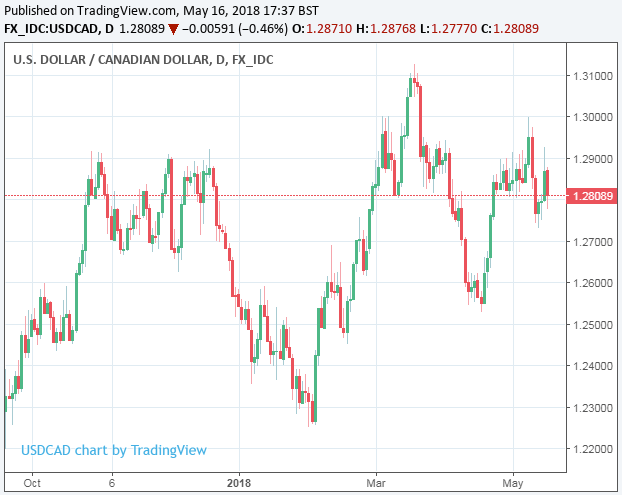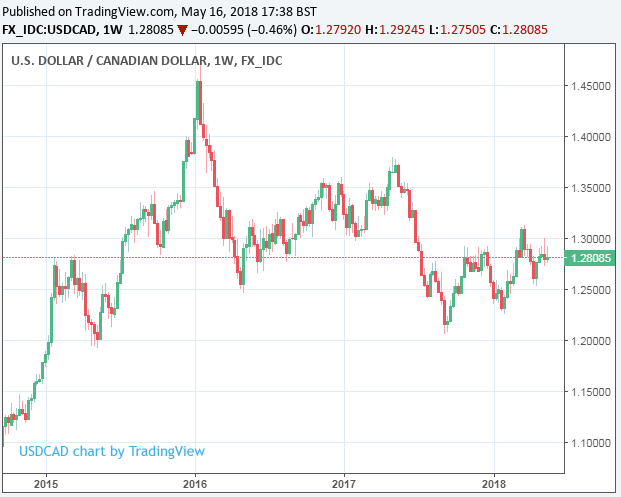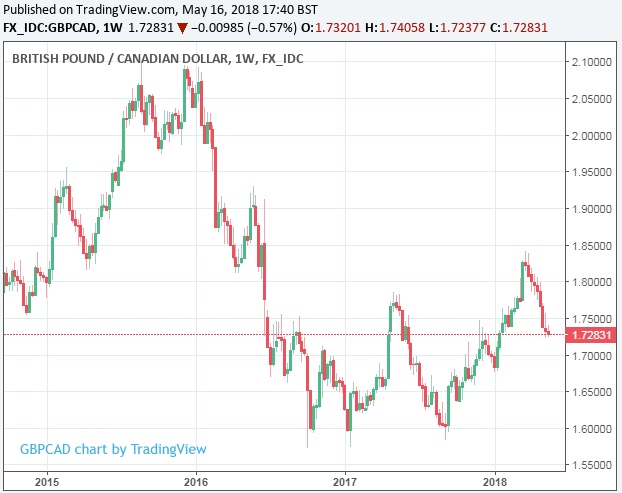Canadian Dollar Forecast to Recover Lost Ground from US Dollar, Hold Steady against Pound
- Written by: James Skinner
-CAD set for a break as USD already past its Zenith, say J.P. Morgan.
-USD/CAD forecast to trend lower in 2018, GBP/CAD to hold steady.
-TD Securities disagree and forecast renewed weakness for the Loonie.

© COSPV, Adobe Stock
The Canadian Dollar is likely to recover lost ground from the US Dollar and hold its own against a strengthening Pound during the months ahead, according to the latest forecasts from J.P. Morgan, as the US Dollar rally of recent weeks has likely already reached its zenith.
Already the Canadian Dollar has outperformed many of its developed world rivals since the beginning of April when the US Dollar was shocked back into life by events in the bond market, as it has benefitted from a sharp increase in oil prices and an earlier clearout of stale speculative long and short positions in the currency.
That relative outperformance has left the Canadian Dollar sitting on only a fractional loss against the greenback three weeks after the initial shift in the US Dollar and more than 4% higher against the Pound. This contrasts against losses of more than 3% for the Yen, 4% for the Euro and between 4% and 5% for the Australian and New Zealand Dollars.

Above: USD/CAD rate shown at daily intervals.
"A local peaking of US-CA rate spreads and lingering chance of NAFTA breakthrough announcement should keep CAD supported in the near-term," says Daniel Hui, an FX strategist at J.P. Morgan.
"Spreads", or differences between the bond yields of two countries, have a significant influence on exchange rates. In the case of the US and Canada, higher short and long term bond yields investors have induced investors and speculators into selling the Canadian currency in order to buy US Dollars and bonds for their increasingly superior returns for a while now.
However, the allure of higher yields south of the border has become more powerful since late April when the 10 year US bond yield first tested the waters of multi-year highs above the 3% threshold. Those yields are now settled firmly above the 3% level while the interest return offered by the Canadian 10 year has risen only to 2.48%.
"Spreads should have peaked for now, not just because of the US CPI disappointment earlier this week, but because the earlier momentum in relative data surprises supporting this spread widening earlier this year has reversed. Meanwhile, there still remains a possibility of the near-term NAFTA 'in principle agreement',"says Hui.
Hui and the J.P. Morgan team's idea that an "in principle agreement" between Canada, the US and Mexico on the future of the North American Free Trade Agreement could emerge over the coming week would offer a significant source of support to the Canadian currency if it were to materialise. This is important for the Loonie because analysts have previously estimated a withdrawal by the US could hit the Canadian economy and see the currency fall by as much as 20%.
However, the July Mexican presidential election is now looming and US midterm elections are set for November, both of which are now putting negotiators' backs up against the wall. Moreover, House of Representatives Speaker Paul Ryan said last week negotiators have until Thursday May 17 to agree a deal if it is to get through Congress before January when US electoral maths could become more complicated.

Above: USD/CAD rate shown at weekly intervals.
"Beyond the near-term dynamics discussed above, our medium-term expectations continues to hold that a Fed and BoC normalizing rates at a roughly parallel pace will keep USD/CAD bounded in a 1.22-1.28 range, with oscillations within the range determined by the relative ebbs and flow of relative cyclical performance," Hui writes, in a recent note.
Both the Bank of Canada and Federal Reserve are in the midst of a monetary policy tightening cycle and are each expected to raise interest rates a total of three times during 2018, which would leave the Canadian cash rate just 25 basis points below the US Fed Funds rate and give the Loonie firm support over the coming months.
Hui and the J.P. Morgan team forecast the Canadian Dollar will rise against its North American rival this year, pushing the USD/CAD rate down from 1.28 Wednesday to 1.26 before the end of June and 1.25 by the end of September. Their year end forecast is for USD/CAD to sit at 1.24.
They also project the Pound-to-Canadian-Dollar rate will fall from 1.73 Wednesday to 1.66 by the end of June, but that it will recover steadily from their back to 1.73 before year-end.

Above: Pound-to-Canadian-Dollar rate shown at weekly intervals.
However, not everybody is as optimistic as J.P. Morgan in their outlook for the Canadian currency during the weeks and months ahead.
"Despite the recent surge in oil prices, the loonie continues to languish. Indeed, if you look at the old weekly (10y) betas crude oil at $70/bbl translates into USDCAD below 1.20. Instead, it is trading at a level consistent with $53/bbl. We believe there is a good reason for this, especially since CAD's role as oil currency does not match with the structural changes in the economy since the introduction of US shale," says Mark McCormick, North American head of FX strategy at TD Securities.
McCormick and the TD team argue the Canadian Dollar's nature has changed in recent years but the simultaneous recovery of oil prices during the time since January 2016 has obscured this from view and distorted perceptions of what has been driving the Canadian currency market.
They say the Loonie is now becoming a "credit currency" as the end of the post-crisis monetary policy era of record low interest rates and quantitative easing comes to an end, arguing that this will have implications for the currency over the coming and its responses to data and changing market conditions over the coming quarters.
"This backdrop does not portend a crisis, but it also means that Canadian [financial conditions] tighten as the costs of USD liquidity rise. Canadian banks are wholesale funders, so the rising cost of USD liquidity is likely to see pass-through from banks to consumers regardless of the BoC's policy rate. It may also be a reason the Bank wants to run the economy hot," says McCormick.
TD Securities argues that with a large current account deficit, which reflects the mismatch between the amount of money coming and going from Canada as well as the amount it is borrowing from overseas, does not bode well for the Loonie in an era when global interest rates are rising and international funding becoming more expensive.
"Divergence in rate spreads, a soggy growth backdrop, and a large current account deficit leaves Canada reliant on the kindness of strangers to fund its external gap. In turn, we eye another go at 1.30 in USDCAD," McCormick concludes.
Advertisement
Get up to 5% more foreign exchange by using a specialist provider to get closer to the real market rate and avoid the gaping spreads charged by your bank when providing currency. Learn more here.




